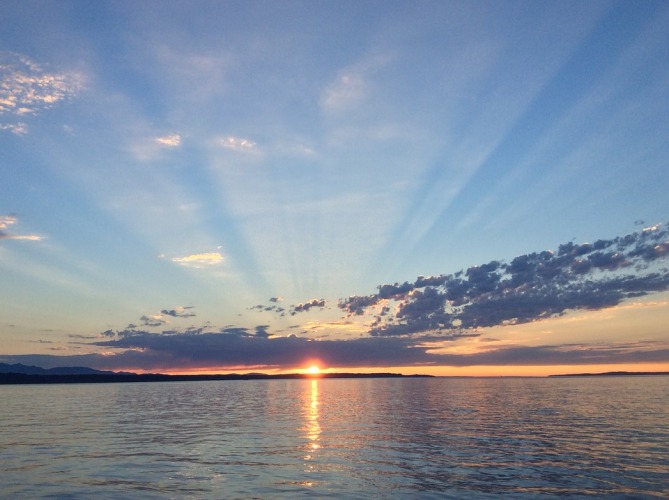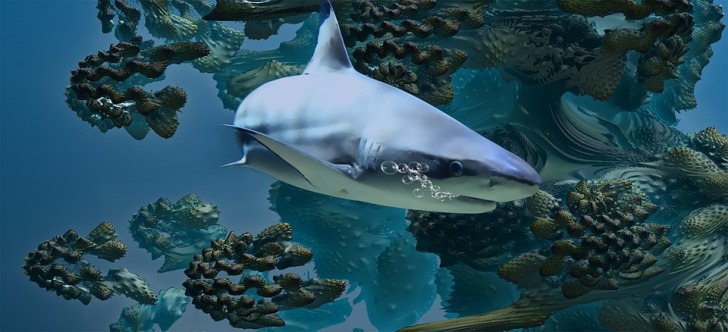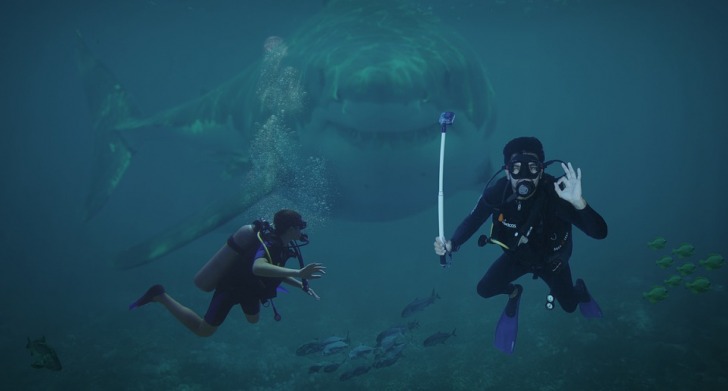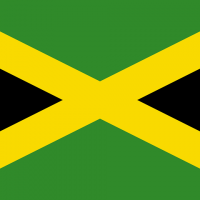If you are afraid of sharks, one place to conquer that fear is in Puget Sound.
Apparently, a coconut falling on someone’s head would happen more often.
Only two non-fatal attacks occurred on this Washington state island ever, and those occurred in 1989 and 2017.
In fact, attacks around the world do not happen very often at all.
Contents
So… Are There Sharks in Puget Sound?
Almost a dozen species of sharks have either shown up occasionally or lived permanently in the Puget Sound waters.
The most prevalent surface-level sharks do not harm people and are small and usually eat other fish – not people.
Most of the larger sharks spend their days in deep waters, and the most prevalent danger does not involve bites or attacks, as you will learn below about the Dogfish shark.

10 Shark Species in Puget Sound
- Sixgill – The largest shark to inhabit Puget Sound waters the most often is the Sixgill, and it is approximately 16-20 feet long. Even though they have the teeth for it, they do not prey upon humans, and they reside at about 5,000-6,000 feet below sea level. It eats a variety of fish and sea creatures.
- The Salmon Shark – It stays at or near sea level, but it does not attack people. This mackerel shark feeds on salmon and also consumes herring, squid, and sablefish. Sometimes, it does rise to the surface but also moves around at approximately 2,000 feet below sea level.
- Spiny Dogfish – Dogfish sharks only extend to about 3-5 feet long. The poisonous spine of the dogfish shark that also resides here poses more of a threat, whereas it does not have an interest in feeding on humans. This deep-water shark swims as low as 4,055 feet below sea level but also can rise to the surface. Some favorite “eats” include herring, shrimp, crab, or squid.
- Brown Catshark – This fish typically reaches a maximum of 31 inches. It normally does not bother humans too much, but it causes a nuisance if harvesters do not intend to catch it in a net or trap. This bottom-feeder eats a variety of fish and animals with no spines (invertebrates) while roaming around at about 4,256 feet below the surface. They sometimes almost come up to the waterline at approximately 108 feet below sea level, and their diet often includes shrimp, squid, and a variety of small fish.
- Broadnose Sevengills – They grow to about 9 feet long, and often spend time in coastal areas. They classify as near threatened by the International Union for Conservation of Nature, which means they could face becoming endangered in the future. This surface fish only swims to about 446 feet below sea level. It has quite a range of food tastes, and it might even prey on other sharks and dolphins, porpoises, and seals.
- Basking – The size of this shark’s mouth could engulf an entire human, which this sea creature could swallow whole. However, the most damage possibly done by this shark relates to accidents rather than intentional attacks on a human. It does reach lengths of 40-45 feet, but you will not be seeing this one often in the Washington area. If you do, it is probably one of the “friendliest” to humans you will meet and stays at the surface but dips to about 656 feet underwater. It usually just opens its mouth up to let tiny fish into it.
- Pacific Angel – This one reaches 5-7 feet in length and swims at around 600 feet below the water’s surface and up. It usually eats crustaceans and bony fish, and skates or cephalopods, such as squid and octopuses.
- Common Thresher – It extends to approximately 18 feet and swims around 1,200 feet underwater and sometimes rises above the surface. They often eat squid, sardines, mackerel, and hake or anchovies.
- Pacific Sleeper – They can grow up to 14 feet and sometimes swim to as deep as 6,480 feet below the water’s surface. Some foods they consume include octopus and crabs or tritons. They might also eat seals.
- Blue – It swims at about 2,000 feet below sea level to the water’s surface. This shark grows to approximately 12 feet and loves fish, such as cod, haddock, or hake. It also may eat squid or seals.
- Great White (the occasional visitor) – This one has a similar shape and appearance as the Salmon Shark. Therefore, people often mistake one for the other. It does not show up in Puget Sound as often as other species. One of its carcasses reportedly made its way to Vashon Island sometime before 2013. Males grow to about 11-13 feet and females 15-16 feet. Two foods it loves include sea lions and seals.
The sharks that sometimes travel to Puget Sound typically come from the Pacific Ocean.
Others might even migrate from the Atlantic.
Dogfish, Sixgills, Broadnose Sevengills, and Brown Catsharks seem to reside in this area the most.

Is it Safe to Swim in Puget Sound?
The risk of shark accidents remains moderately low.
However, the water measures at temperatures averaging between 52-54 degrees.
If staying underwater too long, swimmers could experience shock that makes them unresponsive and susceptible to drowning.
Everyone should bring some type of inflatable device to remain afloat and watch out for glass, broken fish shells, and boaters.
10 Puget sound beaches also had no-contact bacteria alerts as of July 2021, so check out for updates on those.
The water contamination experienced in this area resulted from heat waves, by the way, and this could possibly change the way sharks behave.
Interesting Shark Facts in Puget Sound
The Seattle Aquarium provides local and global information about sharks, and this includes fun facts about their body composition and functions.
Here are examples of a few:
- Shark skeletons consist primarily of cartilage, not bones.
- Most sharks appear on the surface at dawn and dusk.
- They detect scents from up to about 1400 feet.
- These sea creatures never run out of teeth.
Not to frighten you, but rare attacking incidences do occur as mentioned.
However, the two non-fatal Washington shark attacks both occurred in Grays Harbor County, so if you could say there was a “shark hotspot,” you might want to avoid that region.
It is at least two hours’ driving distance from Puget Sound, so you should not have to worry.
In case you are curious, here’s the story of the two attacks:
- The first shark attacked in 1989 at Pacific Beach and took a bite out of a man’s forearm while he lie on his surfboard.
- No injury occurred during the second incident in 2017, but a man’s surfboard was damaged.
Just be careful when swimming or riding the waves.
Salt from the Pacific Ocean does trickle into the area.
However, freshwater travels to Puget Sound from the Duwamish River, which connects to Harbor Island downstream from the Green River.
The shark species that live in this area do survive in both freshwater and saltwater.
However, they often have to work their lungs harder and urinate more often when navigating through freshwater.
The Sound consists of approximately 83 percent ocean water, which equals a little more than 28.5 parts of salt per thousand.
This comes close to the Pacific salt ratio levels, which measure at about 34 per thousand or about 2.5 percent.
The amount of salt present makes it possible for sharks to survive here if they were to migrate from the sea, but that still does not mean they would prey upon humans.
Safety Tips for Swimming in Shark-infested Waters
You can put your mind at ease if you follow recommended safety practices when swimming in shark-infested waters.
These include not entering places contaminated by sludge or where Baitfish congregate.
You also might have heard that you should not wear shiny jewelry or go swimming with an uneven tan.
It is also helpful to learn some Coast Guard safety procedures, such as how to signal for help.
Additionally, follow these three priority precautions.
3 Priority Precautions to Take
BONUS WARNING:
Do not swim near sharks if you see them or enter waters where it says “no swimming allowed.”
You also should think twice about swimming at night, especially if alone.
Remember these three bits of important advice about entering Puget sound waters too:
- Bring along swimming buddies – A minimum of one other person could save you from a world of hurt. Having two or more people could even provide you more safety because one person can care for an injured individual while another seeks out help.
- Stay close to the shore – It is easier to access the help you need that way, especially if you do not have a waterproof phone case. It also prevents you from losing your communication devices.
- Do not go in with an open cut – Sharks can smell this, and it could cause them to come looking for you. Wait until you stop bleeding and a scab has covered over your wound before entering the water.

Divers and a shark
Summary
Puget Sound shark attack risk remains low.
Only a couple of non-fatal accidents occurred near the Puget Sound region in 28 years, which affected surfers.
Still, you can take precautions that may put you at ease if you suffer from a fear of sharks.
Just in case, it is also wise to know how to prevent attracting the attention of potential dangerous sea creatures.
Sources
- https://patch.com/washington/across-wa/shark-attack-your-wa-beach-how-likely-happen
- https://www.reddit.com/r/SeattleWA/comments/ecw51c/sharks_that_have_been_found_in_puget_sound/
- https://komonews.com/news/local/shark-population-increases-in-puget-sound-area
- https://www.sciencedirect.com/topics/agricultural-and-biological-sciences/broadnose-sevengill-shark
- https://www.fisheries.noaa.gov/species/atlantic-spiny-dogfish
- https://ecology.wa.gov/Blog/Posts/July-2021/Fecal-Matters-10-beaches-in-Puget-Sound-under-no-c
- http://www.sharkattackdata.com/attack/united_states_of_america/washington/1989.04.12
- https://www.burkemuseum.org/static/FishKey/aboutps.html
- https://www.floridamuseum.ufl.edu/discover-fish/sharks/how-to-avoid-shark-attacks/
- https://www.britannica.com/animal/basking-shark
Frequently Asked Questions
How many people die every year from Puget Sound shark attacks?
Shark fatalities never occurred in the Sound, and only about four people around the world lose their lives from sharks.
Some of these incidences, however, may result from mishandling or accidents versus an attack.
Does Puget Sound have the largest sharks in the world?
The Basking Shark that occasionally migrates to the Pacific Coast near Washington grows to a maximum of 40-45 feet.
It is one of the largest, but it is not as long as the Whale Shark that can grow to more than 60 feet in length.
Are the Puget Sound sharks becoming extinct?
The IUCN categorized about 63 percent of the 500 sharks found in the world as near threatened, meaning, they could become endangered in the future.
One urgent concern involves the washing up of four Sixgill sharks along the Sound shoreline as reported in 2021.
Other species, such as the Broadnose Sevengills could risk endangerment, and the IUCN has rated the Basking Shark as “endangered.”
Its slow reproductive cycle does not seem to make up for the demands, and commercial harvesting continues to affect the existence of this species.
Are most sharks dangerous?
Only about a dozen sharks found around the world pose a threat to humans.
Fortunately, you do not have to worry much in the Puget Sound area.
Just make sure you follow all recommended safety procedures and only enter designated recreational areas.












I caught a hammerhead shark off the pier by alki beach in. 1979. I notice you don’t have them on your list. The shark was 3 feet in size.
It seems that there is a low risk of shark attacks in Puget Sound and the surrounding areas, with only a few non-fatal incidents occurring in the past few decades.